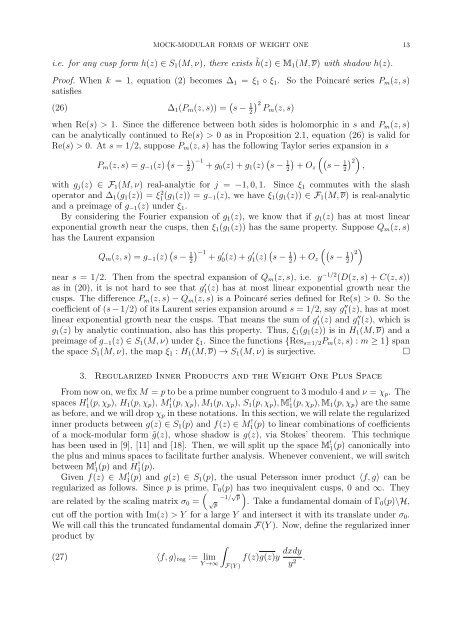Mock-modular forms of weight one - UCLA Department of Mathematics
Mock-modular forms of weight one - UCLA Department of Mathematics
Mock-modular forms of weight one - UCLA Department of Mathematics
Create successful ePaper yourself
Turn your PDF publications into a flip-book with our unique Google optimized e-Paper software.
MOCK-MODULAR FORMS OF WEIGHT ONE 13<br />
i.e. for any cusp form h(z) ∈ S 1 (M, ν), there exists ˜h(z) ∈ M 1 (M, ν) with shadow h(z).<br />
Pro<strong>of</strong>. When k = 1, equation (2) becomes ∆ 1 = ξ 1 ◦ ξ 1 . So the Poincaré series P m (z, s)<br />
satisfies<br />
(26) ∆ 1 (P m (z, s)) = ( s − 1 2) 2<br />
Pm (z, s)<br />
when Re(s) > 1. Since the difference between both sides is holomorphic in s and P m (z, s)<br />
can be analytically continued to Re(s) > 0 as in Proposition 2.1, equation (26) is valid for<br />
Re(s) > 0. At s = 1/2, suppose P m (z, s) has the following Taylor series expansion in s<br />
P m (z, s) = g −1 (z) ( s − 1 2) −1<br />
+ g0 (z) + g 1 (z) ( s − 1 2)<br />
+ Oz<br />
( (s<br />
−<br />
1<br />
2<br />
) 2<br />
)<br />
,<br />
with g j (z) ∈ F 1 (M, ν) real-analytic for j = −1, 0, 1. Since ξ 1 commutes with the slash<br />
operator and ∆ 1 (g 1 (z)) = ξ1(g 2 1 (z)) = g −1 (z), we have ξ 1 (g 1 (z)) ∈ F 1 (M, ν) is real-analytic<br />
and a preimage <strong>of</strong> g −1 (z) under ξ 1 .<br />
By considering the Fourier expansion <strong>of</strong> g 1 (z), we know that if g 1 (z) has at most linear<br />
exp<strong>one</strong>ntial growth near the cusps, then ξ 1 (g 1 (z)) has the same property. Suppose Q m (z, s)<br />
has the Laurent expansion<br />
Q m (z, s) = g −1 (z) ( s − 1 2) −1<br />
+ g<br />
′<br />
0 (z) + g ′ 1(z) ( s − 1 2)<br />
+ Oz<br />
( (s<br />
−<br />
1<br />
2<br />
near s = 1/2. Then from the spectral expansion <strong>of</strong> Q m (z, s), i.e. y −1/2 (D(z, s) + C(z, s))<br />
as in (20), it is not hard to see that g 1(z) ′ has at most linear exp<strong>one</strong>ntial growth near the<br />
cusps. The difference P m (z, s) − Q m (z, s) is a Poincaré series defined for Re(s) > 0. So the<br />
coefficient <strong>of</strong> (s − 1/2) <strong>of</strong> its Laurent series expansion around s = 1/2, say g 1(z), ′′ has at most<br />
linear exp<strong>one</strong>ntial growth near the cusps. That means the sum <strong>of</strong> g 1(z) ′ and g 1(z), ′′ which is<br />
g 1 (z) by analytic continuation, also has this property. Thus, ξ 1 (g 1 (z)) is in H 1 (M, ν) and a<br />
preimage <strong>of</strong> g −1 (z) ∈ S 1 (M, ν) under ξ 1 . Since the functions {Res s=1/2 P m (z, s) : m ≥ 1} span<br />
the space S 1 (M, ν), the map ξ 1 : H 1 (M, ν) → S 1 (M, ν) is surjective.<br />
□<br />
3. Regularized Inner Products and the Weight One Plus Space<br />
From now on, we fix M = p to be a prime number congruent to 3 modulo 4 and ν = χ p . The<br />
spaces H 1(p, ! χ p ), H 1 (p, χ p ), M 1(p, ! χ p ), M 1 (p, χ p ), S 1 (p, χ p ), M ! 1(p, χ p ), M 1 (p, χ p ) are the same<br />
as before, and we will drop χ p in these notations. In this section, we will relate the regularized<br />
inner products between g(z) ∈ S 1 (p) and f(z) ∈ M 1(p) ! to linear combinations <strong>of</strong> coefficients<br />
<strong>of</strong> a mock-<strong>modular</strong> form ˜g(z), whose shadow is g(z), via Stokes’ theorem. This technique<br />
has been used in [9], [11] and [18]. Then, we will split up the space M ! 1(p) canonically into<br />
the plus and minus spaces to facilitate further analysis. Whenever convenient, we will switch<br />
between M ! 1(p) and H 1(p).<br />
!<br />
Given f(z) ∈ M 1(p) ! and g(z) ∈ S 1 (p), the usual Petersson inner product 〈f, g〉 can be<br />
regularized as follows. Since p is prime, ( Γ 0 (p) has two inequivalent cusps, 0 and ∞. They<br />
−1/<br />
are related by the scaling matrix σ 0 =<br />
√ p<br />
√ p<br />
). Take a fundamental domain <strong>of</strong> Γ 0 (p)\H,<br />
cut <strong>of</strong>f the portion with Im(z) > Y for a large Y and intersect it with its translate under σ 0 .<br />
We will call this the truncated fundamental domain F(Y ). Now, define the regularized inner<br />
product by<br />
(27) 〈f, g〉 reg := lim<br />
Y →∞<br />
∫<br />
F(Y )<br />
f(z)g(z)y dxdy<br />
y 2 .<br />
) 2<br />
)
















